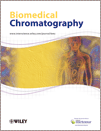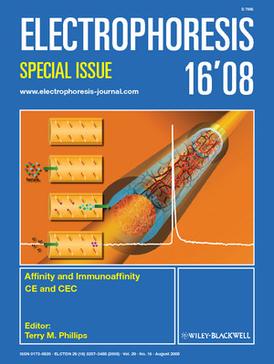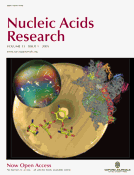
Nucleic acids are biopolymers, macromolecules, essential to all known forms of life. They are composed of nucleotides, which are the monomer components: a 5-carbon sugar, a phosphate group and a nitrogenous base. The two main classes of nucleic acids are deoxyribonucleic acid (DNA) and ribonucleic acid (RNA). If the sugar is ribose, the polymer is RNA; if the sugar is the ribose derivative deoxyribose, the polymer is DNA.

Biological databases are libraries of biological sciences, collected from scientific experiments, published literature, high-throughput experiment technology, and computational analysis. They contain information from research areas including genomics, proteomics, metabolomics, microarray gene expression, and phylogenetics. Information contained in biological databases includes gene function, structure, localization, clinical effects of mutations as well as similarities of biological sequences and structures.
Proceedings of the Royal Society is the main research journal of the Royal Society. The journal began in 1831 and was split into two series in 1905:
The European Bioinformatics Institute (EMBL-EBI) is an intergovernmental organization (IGO) which, as part of the European Molecular Biology Laboratory (EMBL) family, focuses on research and services in bioinformatics. It is located on the Wellcome Genome Campus in Hinxton near Cambridge, and employs over 600 full-time equivalent (FTE) staff. Institute leaders such as Rolf Apweiler, Alex Bateman, Ewan Birney, and Guy Cochrane, an adviser on the National Genomics Data Center Scientific Advisory Board, serve as part of the international research network of the BIG Data Center at the Beijing Institute of Genomics.

"Molecular Structure of Nucleic Acids: A Structure for Deoxyribose Nucleic Acid" was the first article published to describe the discovery of the double helix structure of DNA, using X-ray diffraction and the mathematics of a helix transform. It was published by Francis Crick and James D. Watson in the scientific journal Nature on pages 737–738 of its 171st volume.

The Journal of Molecular Biology is a biweekly peer-reviewed scientific journal covering all aspects of molecular biology. It was established in 1959 and is published by Elsevier. The editor-in-chief is Peter Wright.

Amos Bairoch is a Swiss bioinformatician and Professor of Bioinformatics at the Department of Human Protein Sciences of the University of Geneva where he leads the CALIPHO group at the Swiss Institute of Bioinformatics (SIB) combining bioinformatics, curation, and experimental efforts to functionally characterize human proteins.
Charles R. Cantor is an American molecular geneticist who, in conjunction with David Schwartz, developed pulse field gel electrophoresis for very large DNA molecules. Cantor's three-volume book, Biophysical Chemistry co-authored with Paul Schimmel, was an influential textbook in the 1980s and 1990s.

David J. Lipman is an American biologist who from 1989 to 2017 was the director of the National Center for Biotechnology Information (NCBI) at the National Institutes of Health. NCBI is the home of GenBank, the U.S. node of the International Sequence Database Consortium, and PubMed, one of the most heavily used sites in the world for the search and retrieval of biomedical information. Lipman is one of the original authors of the BLAST sequence alignment program, and a respected figure in bioinformatics. In 2017, he left NCBI and became Chief Science Officer at Impossible Foods.
The DNA Data Bank of Japan (DDBJ) is a biological database that collects DNA sequences. It is located at the National Institute of Genetics (NIG) in the Shizuoka prefecture of Japan. It is also a member of the International Nucleotide Sequence Database Collaboration or INSDC. It exchanges its data with European Molecular Biology Laboratory at the European Bioinformatics Institute and with GenBank at the National Center for Biotechnology Information on a daily basis. Thus these three databanks contain the same data at any given time.
The Database of Macromolecular Motions is a bioinformatics database and software-as-a-service tool that attempts to categorize macromolecular motions, sometimes also known as conformational change. It was originally developed by Mark B. Gerstein, Werner Krebs, and Nat Echols in the Molecular Biophysics & Biochemistry Department at Yale University.

The Pathogen-Host Interactions database (PHI-base) is a biological database that contains curated information on genes experimentally proven to affect the outcome of pathogen-host interactions. The database is maintained by researchers at Rothamsted Research, together with external collaborators since 2005. Since April 2017 PHI-base is part of ELIXIR, the European life-science infrastructure for biological information via its ELIXIR-UK node.

The FEBS Journal is a biweekly peer-reviewed scientific journal published by John Wiley & Sons on behalf of the Federation of European Biochemical Societies. It covers research on all aspects of biochemistry, molecular biology, cell biology, and the molecular bases of disease. The editor-in-chief is Seamus Martin, who took over from Richard Perham in 2014.

Biomedical Chromatography is a monthly peer-reviewed scientific journal, published since 1986 by John Wiley & Sons. It covers research on the applications of chromatography and allied techniques in the biological and medical sciences. The editor-in-chief is Michael Bartlett.

Electrophoresis is a peer-reviewed scientific journal covering all aspects of electrophoresis, including new or improved analytical and preparative methods, development of theory, and innovative applications of electrophoretic methods in the study of proteins, nucleic acids, and other compounds.
Acta Crystallographica is a series of peer-reviewed scientific journals, with articles centred on crystallography, published by the International Union of Crystallography (IUCr). Originally established in 1948 as a single journal called Acta Crystallographica, there are now six independent Acta Crystallographica titles:
Biochimica et Biophysica Acta (BBA) is a peer-reviewed scientific journal in the field of biochemistry and biophysics that was established in 1947. The journal is published by Elsevier with a total of 100 annual issues in ten specialised sections.

Journal of Biological Inorganic Chemistry is a peer-reviewed scientific journal. It is an official publication of the Society of Biological Inorganic Chemistry and published by Springer Science+Business Media.

Biosensors and Bioelectronics is a peer-reviewed scientific journal published by Elsevier. It covers research on biosensors and bioelectronics. The journal was established in 1985 as Biosensors and obtained its current name in 1991. The journal was established by I. John Higgins, W. Geoff Potter and Anthony P.F. Turner, who became editor-in-chief, until his retirement in 2019. The current Editors in Chief are Chenzhong Li, Arben Merkoçi, and Man Bock Gu.

Stem Cells is a peer-review scientific journal of cell biology. It was established as The International Journal of Cell Cloning in 1983, acquiring its current title in 1993.













